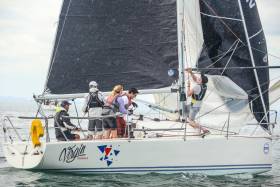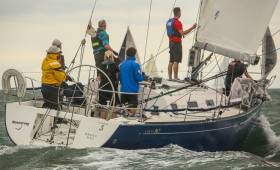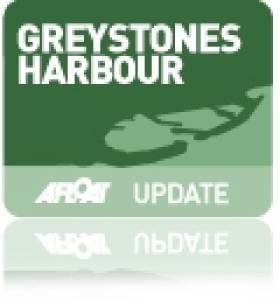Displaying items by tag: Taste of Greystones
Taste of Greystones 2023 Sees Action Despite Difficult Conditions
On its 10th anniversary and in very difficult conditions, the 2023 Taste of Greystones Regatta hosted by Greystones Sailing Club managed to set two races off over the two days (Saturday, 26 and Sunday, 27 August).
With over 60 entries, the event yet again proved its popularity with entries from Malahide, Poolbeg, Dun Laoghaire, Bray, Wicklow, Arklow and Courtown, as well as the home club Wicklow.
Winner of Class 1 was Crazy Diamond, the Archambault 31 helmed by Paddy Barnwell, while the Corby 25 Fusion came first in Class 2, the Impala 28 Kahera topped the Class 3 table, and the Elan 333 White Pearl led the non-spinnakers.
 James Kirwan, General Manager of sponsor BJ Marine, presents Paddy Barnwell, helm of Crazy Diamond, with the Taste of Greystones Regatta Trophy
James Kirwan, General Manager of sponsor BJ Marine, presents Paddy Barnwell, helm of Crazy Diamond, with the Taste of Greystones Regatta Trophy
Also entered were four Dublin Bay 21s who competed in a class of 24 White Sail class boats
In addition, this year’s Taste of Greystones hosted the inaugural Formula One class Nationals as the club looks to reconstitute this great class. The Nationals were won by Usain Boat, skippered by Marty O’Leary.
 Four Dublin Bay 21s competed in a class of 24 White Sail class boats at the Taste of Greystones Regatta
Four Dublin Bay 21s competed in a class of 24 White Sail class boats at the Taste of Greystones Regatta
Download overall results below as jpeg files
Following last year’s expansion to two days, the 2023 Taste of Greystones Regatta hosted by Greystones Sailing Club will once again be a weekend affair on 26-27 August.
As with the 2022 event, Saturday’s late single race will have a first start at 3.30 pm to allow clubs time to allow visiting keelboats plenty of time to get to Greystones Marina in Co Wicklow.
Two races are scheduled for Sunday morning, with the first gun at 10.55 am and the aim to have everybody off the water by 2.30 pm.
 Keelboats are invited to get a ‘Taste’ of racing off Greystones in this season closer on the weekend of 26-27 August
Keelboats are invited to get a ‘Taste’ of racing off Greystones in this season closer on the weekend of 26-27 August
Sponsored again by BJ Marine, the event continues to put a premium on hospitality with complimentary food on both days, plus beer vouchers for all crews.
“We can’t guarantee the wind conditions,” regatta director Daragh Cafferky says, “but we can guarantee a warm welcome.”
The NOR, entry form and boat registration links are now available on the club website GSC.ie.
A fleet of ten or more will compete for IRC Zero honours in a 41-boat fleet for this weekend's Taste of Greystones Regatta in County Wicklow.
The IRC Zero fleet will range from a Cape 31 to a First 50 and include some of Dublin Bay's biggest boats.
Light winds and strong tides are on the cards for the annual gathering in the Garden County starting on Saturday afternoon.
Poolbeg Yacht and Boat Club on the River Liffey is sending four boats. Dun Laoghaire will have six. Boats are also coming from Howth and nearby Bray and Arklow Sailing Clubs. Overall, ten east coast clubs will be represented at the end of August celebrations.
A significant change to the event this year will be racing on both Saturday afternoon and Sunday morning to avoid the risk of weather undermining everybody's best efforts. This issue has happened at this race track more than once before.
 Strong winds and big seas for a previous edition of the Taste of Greystones Regatta, but this weekend's forecast indicates light northerlies Photo: Afloat
Strong winds and big seas for a previous edition of the Taste of Greystones Regatta, but this weekend's forecast indicates light northerlies Photo: Afloat
In IRC Zero, Dave Cullen's First 50 Checkmate XX from Howth will be the biggest boat of the regatta, but there are also several 40-foot challengers coming from the DBSC ranks on the Dun Laoghaire's waterfront. Racing is Jonathan Nicholson's Puma 42, El Pocko from the Royal St. George Yacht Club. Muriel Farrell's First 40.7 Tsunami and Tony Fox's A35 Gringo, both from the National Yacht Club, are also slated. Barry Cunnigham's Royal Irish-based newly arrived Cape 31 Blast will meet the local challenge of Daragh Cafferkey's A35, Another Adventure and Steve Hayes's First 34.7, Magic Touch.
 Cruiser Class 1, Cruiser Class 2, Cruiser Class 3 and White Sails Class 4 will be contested at Taste of Greystones Regatta this weekend Photo: Afloat
Cruiser Class 1, Cruiser Class 2, Cruiser Class 3 and White Sails Class 4 will be contested at Taste of Greystones Regatta this weekend Photo: Afloat
There will be a 14-boat Class Two, comprising 31.7s and Sigma 33s, but there will be stiff local competition from Frank Whelan's Corby 25 Fusion and Graeme Noonan's Flash, a Formula 28.
Class three will also compete as well as a White Sails division.
As Afloat reported previously, Saturday's late single race will have a first start at 15.30 to allow competitors time to reach Greystones 'comfortably'.
Taste of Greystones Regatta 2022 (Provisional) Entries. Classes 1-3.
|
1 |
Another Adventure |
Daragh Cafferky |
A35 |
3511 |
|
1 |
Blast |
Barry Cunningham |
3135 |
|
|
1 |
Checkmate XX |
David Cullen |
First 50 |
66 |
|
1 |
El Pocko |
Jonathan Nicholson |
Puma 42 |
6888 |
|
1 |
Gringo |
Tony Fox |
7778 |
|
|
1 |
Madness |
Ian Fagan |
Elan 37 |
9880T |
|
1 |
Magic Touch |
Steve Hayes |
First 34.7 |
4444 |
|
1 |
Tsunami |
Muriel Farrell |
First 40.7 |
4007 |
|
1 |
Aquilina |
James Tyrrell |
j112 |
1507 |
|
1 |
Incorrect |
G Thompson |
ILC 30 |
|
|
2 |
Dearg Doom |
Neil Kearney |
Hanse 350 |
3350 |
|
2 |
Flash |
Graeme Noonan |
Formula 28 |
6998 |
|
2 |
Fusion |
Frank Whelan |
Corby 25 |
2552 |
|
2 |
Gemini |
Ger O Grady |
Sun Od 32 |
5032 |
|
2 |
Impressions |
Brian O'Keefe |
First 30E |
3838 |
|
2 |
Legally Blond |
Gordon Cuthbert |
31.7 |
3175 |
|
2 |
Mayfly |
Anthony Corbet |
31.7 |
1241 |
|
2 |
No Brakes |
Joe Taylor |
First 27.7 |
29003 |
|
2 |
Oystercatcher |
Brian Hett |
GibSea 37 |
1177 |
|
2 |
Wraith |
Ian Barton |
Oceanus 35 |
1462 |
|
2 |
Imprint |
Wicklow |
||
|
2 |
Hydrogen |
P Moran |
Hydro 22 |
1145 |
|
2 |
Showtime |
P Sinnot |
Sigma 33 |
4268 |
|
3 |
Allegro |
Paul Sunderland |
Beneteau 285 |
IRL592 |
|
3 |
Another 1st |
Rhona Byrne |
GB48T |
|
|
3 |
Chouskikou |
Alan Jones |
First 28 |
1689 |
|
3 |
Huntress |
Tony Goold |
Impela |
9607 |
|
3 |
Overdraft |
Joe Bolger |
First 285 |
3145 |
|
3 |
Quartermaster |
Paul Wafer |
1/4 tonner |
2133 |
|
3 |
Starflash |
Barry Keogh |
7149 |
|
|
3 |
Happy Captain |
Nicholson 31 |
||
|
3 |
Eagle |
D Ryan |
Ruffian |
961 |
|
3 |
Bibo |
T Gillespie |
Ruffian |
7034 |
|
4 |
Chase Me |
John Raughter |
Westerley Fulmar |
397 |
|
4 |
Run 'n' L8 |
Celine McQuire |
First 31.7 |
7821 |
|
4 |
Sea Esta |
Philip Mitchell |
Kelt |
1688 |
|
4 |
ZasZasG |
Peter Gyves |
Salty Dog 28 |
|
|
4 |
Gunsmoke |
Pat Darcy |
First 30 |
|
|
4 |
Chipita |
Clodagh Cullen |
Wavquiez |
1296 |
|
4 |
Dragonfly |
Alo McGoldrick |
Ronautica265 |
2653 |
|
4 |
Diamond |
B Malone |
Huzzar 30 |
0 |
‘Taste of Greystones’ Regatta Returns Next Month
Greystones Sailing Club has announced the return of the Taste of Greystones regatta on the weekend of 27-28 August.
A big change to the event this year will be racing on both the Saturday afternoon and Sunday morning, in an effort to avoid the risk of weather undermining everybody’s best efforts.
Saturday’s late single race will have a first start at 15.30 to allow clubs time to reach the East Coast club comfortably.
A big feature of the Taste of Greystones has always been the hospitality, and this is now further enhanced with the support of the Codling Wind Park as hospitality partner.
“The late Satuday race may not suit all the Dublin Bay boats fighting for championship points,” the club says, “but if the crystal is out of reach in Dublin Bay there is still plenty to be had in Greystones and the best social regatta you could treat the crew to.”
The NOR and entry link are now available on the club website GSC.ie.
140–boats are expected off the coast of County Wicklow for the two–race 'Taste of Greystones Trophy' later this month.
Greystones Sailing Club (GSC) will be keeping its fingers crossed for better winds than two years ago when the 2017 edition sets sail this August 26th. In 2015, the event was becalmed and rescheduled but its been the only blot for the newest east coast regatta that has been a runaway–success for the traditional dinghy club. GSC has also been embracing cruiser–racing since the new marina opened in the harbour, four years ago.
Started in 2013, by Greystones Sailing Club, the new cruiser event has focused on the 'social experience Greystones village offers', according to club Commodore Daragh Cafferkey, a regular ISORA sailor.
Clubs from Howth, Clontarf, Poolbeg, Dublin Bay, Bray, Wicklow, Arkow and Courtown – and perhaps some from as far afield as Wales too – are expected in Wicklow for the regatta sponsored by marina operator BJ Marine.
Dun Laoghaire's 'White Mischief' Wins At Taste of Greystones Regatta
Tim Goodbody's J109 White Mischief from the Royal Irish Yacht Club was the winner of Cruisers one ECHO division in today's Taste of Greystones Harbour Regatta. The Greystones Sailing Club regatta was cut short for a second year running by slack winds. Two races were planned but only one was sailed. Full results are downloadable below as a PDF below.
#greystonesharbour – Greystones Sailing Club's annual "Taste of Greystones" Cruiser Regatta will take place on Sunday 31st August. The inaugural event last year attracted 72 cruisers registered with 68 actually racing. This year organiser Joe Taylor hopes to make it even bigger
The entry fee of €50 includes your overnight berth and of course the much talked about BJ Marine Greystones Harbour Marina lunch and refreshments. Also included are various vouchers for the Club bar and for the Beach House.
Hot breakfasts will be available on site Sunday morning followed by two races starting at 10.45. Racing should be completed by about 14.30 and followed by that lunch and the prizegiving. The big bonus is everybody will be home by tea time, says Taylor.
Feeder races on the Saturday for those who would like to race down will have their prizeging in the Greystones Sailing Club clubhouse around 19.30.
More details downloadable below































































